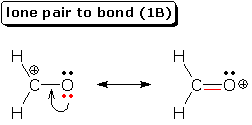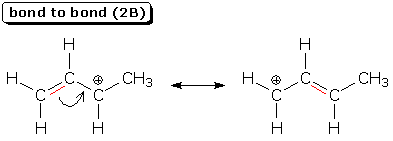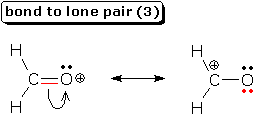
|
|

|
Curved Arrows: 3 Possible Changes Mobile electron pairs A Lewis structure gives us a useful picture of how electrons are organized in a molecule. When we compare Lewis structures of reactants and products (or of different resonance forms), we see that some electrons have changed position, usually in pairs. I will refer to these as mobile electron pairs. (Note: Mobile refers to motion as it appears in drawings, and not to actual motion in space. When it comes to real motion, all electrons are mobile.) Curved arrows are added to Lewis structures to show how mobile electron pairs move. Each arrow points from a mobile pair in the current drawing (origin) to the pair's location in a future drawing (destination).
Origins and destinations Let's talk a little about how an arrow identifies a mobile electron pair (origin) and its future destination. Origins are easily worked out because the arrow's tail is always right next to the mobile electron pair. Look at the chemical reaction below and find the mobile pairs.
The reactants contain two mobile pairs (shown in red). The arrowtails are drawn so that they emerge right out of these pairs. Destinations are indicated by an arrow's head, but the future role of the mobile pair may be hard to figure out. The products of this reaction contain two destinations (shown in red). Both of the arrowheads in the reactants point at atoms (H and O), but one destination is a bond (NH) while the other is a lone pair (O). Destinations are obviously tricky. Fortunately, there are only 2 types of destinations: bonds and lone pairs. Better still, there are only 3 origin-destination combinations and simple rules apply to each.
3 types of change Mobile electron pairs move in just three ways:
Notice that the origin and destination must always have one atom in common. For example, a bond pair connecting atoms A-B (origin) must stay associated with A or B in the destination. The destination can be a lone pair (on A or B) or a bond (A-C or B-C), but it must involve A or B.
Case 1 - Lone pair to bond pair Lone pairs can only change into bond pairs, but there are two ways to draw this. The arrowhead can point to an atom (C in 1A) or a bond (CO in 1B).
The choice between "point arrow at atom" vs. "point arrow at bond" depends on whether a bond already exists at the destination. If a bond is already present (1B), point the arrowhead at this bond. If no bond exists (1A), point the arrow at an atom.
Case 2 - Bond pair to bond pair Bond pair to bond pair changes can also be drawn in two ways. The arrowhead can point at an atom (H in 2A) or a bond (CC in 2B).
It is important to remember that, no matter what the arrow points at, one of the atoms in the original bond will still be part of the destination bond. The choice between "point arrow at atom" vs. "point arrow at bond" depends on whether a bond already exists at the destination. If a bond is present (2B), point the arrow at this bond. If no bond exists (2A), point the arrow at an atom.
Case 3 - Bond pair to lone pair This change can only be drawn one way. The arrow must point from a bond to an atom (O in 3).
Look closely at Formulas 3 and 2A. Both drawings show arrows that point from bonds to atoms, but the original bond changes into a bond in one case (2A), while it changes into a lone pair in the other (3). If an arrow points to a third atom (H in 2A), a new bond is implied. Otherwise, if an arrow points to one of the original bonded atoms (O in 3), a lone pair is implied. Remember: the origin and destination must have at least one atom in common.
Summary Arrows are drawn from mobile electron pairs to atoms or bonds. An arrow points at a bond only when 1) a new bond will form and 2) a bond already exists at this location. Otherwise, the arrow should point at an atom.
Take some time to practice what you have learned so far by trying the problems on these pages: |







